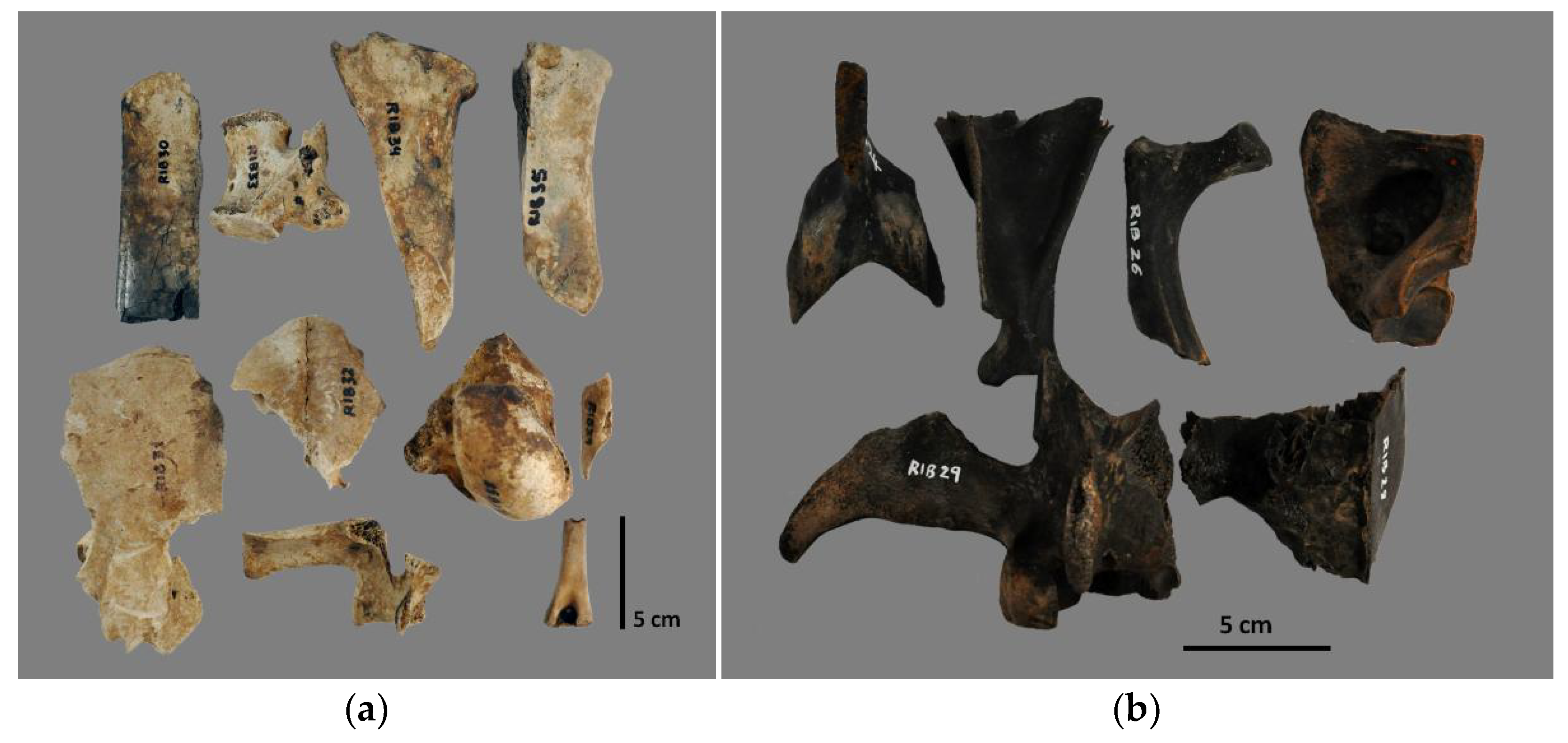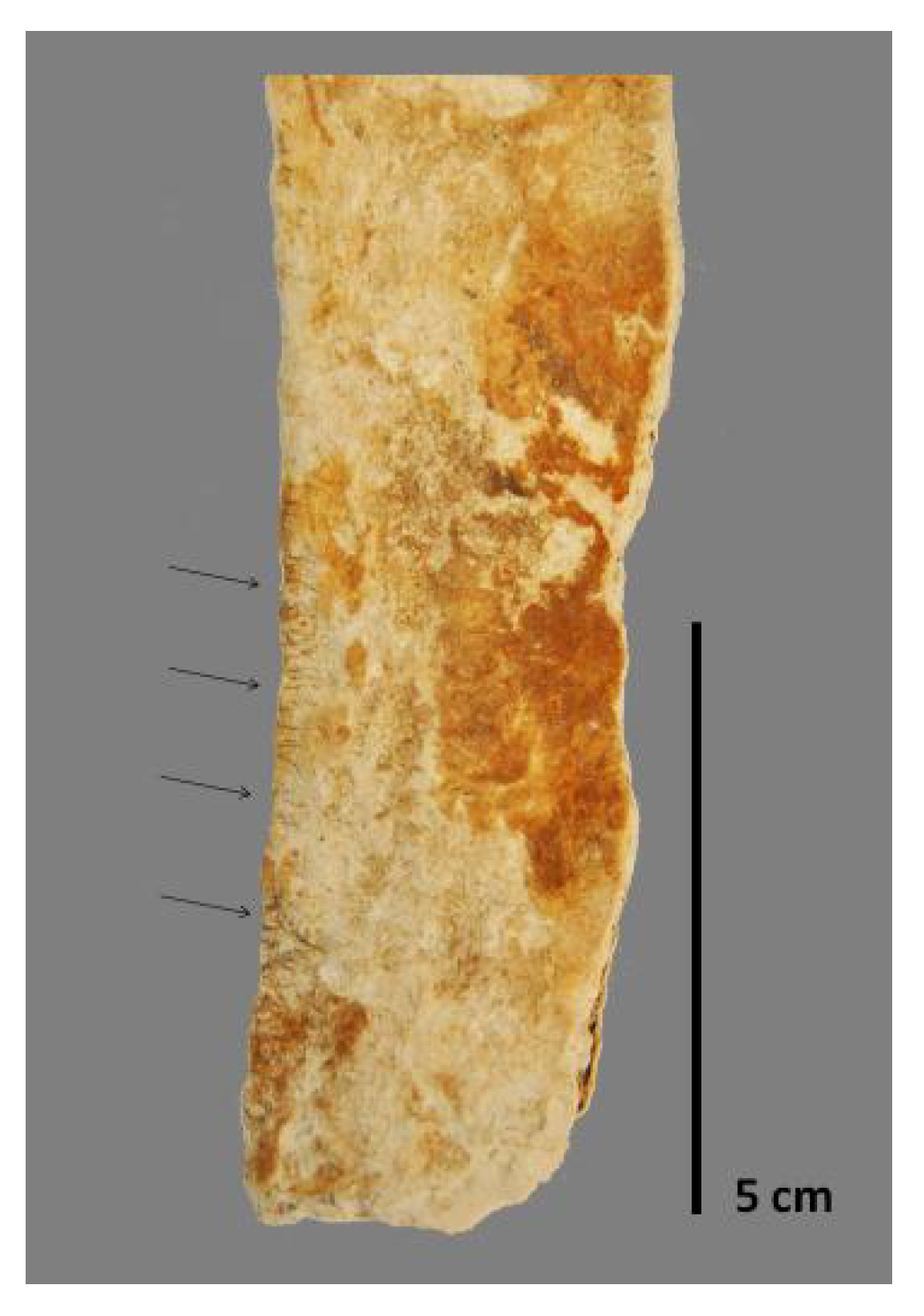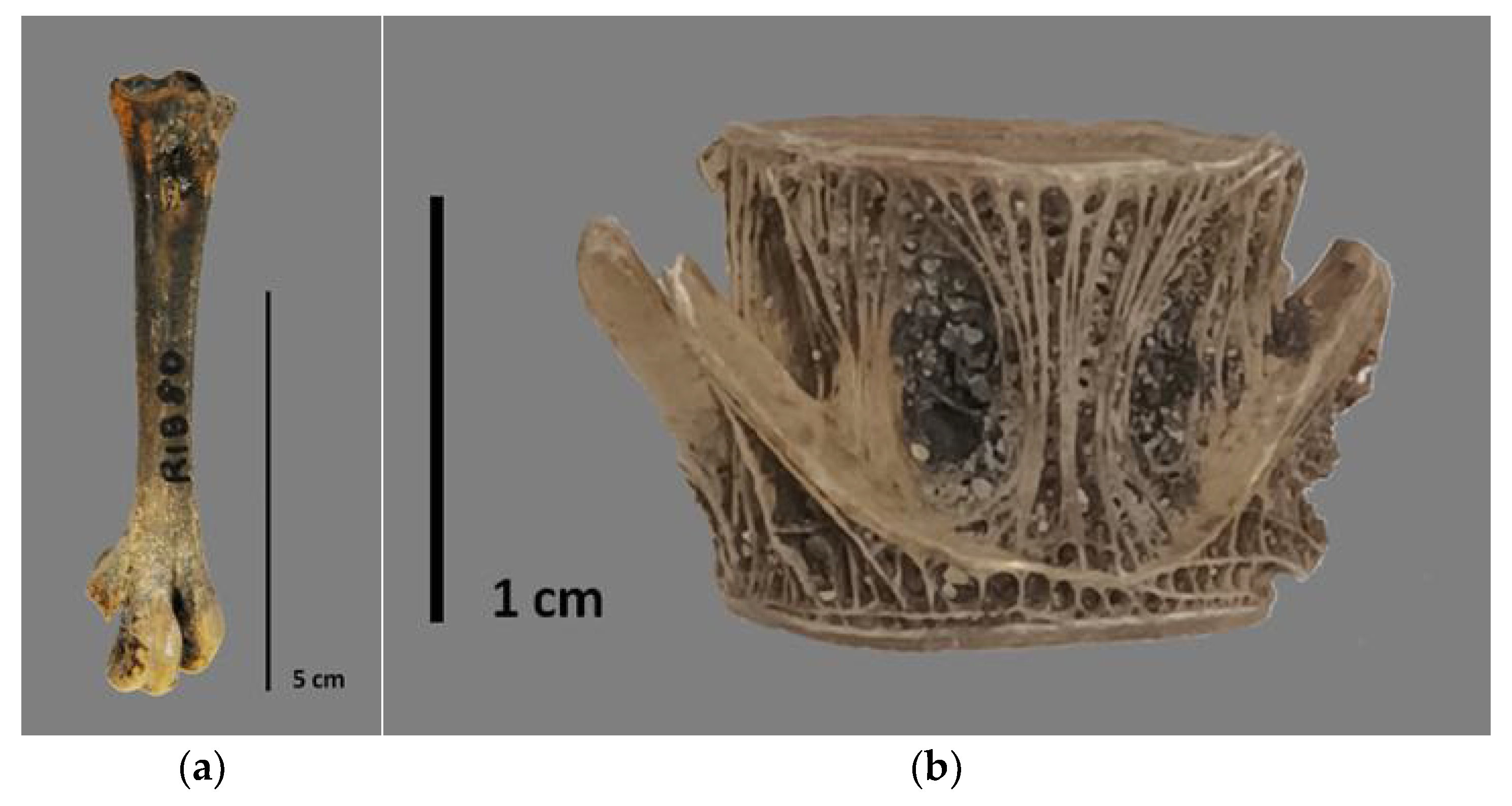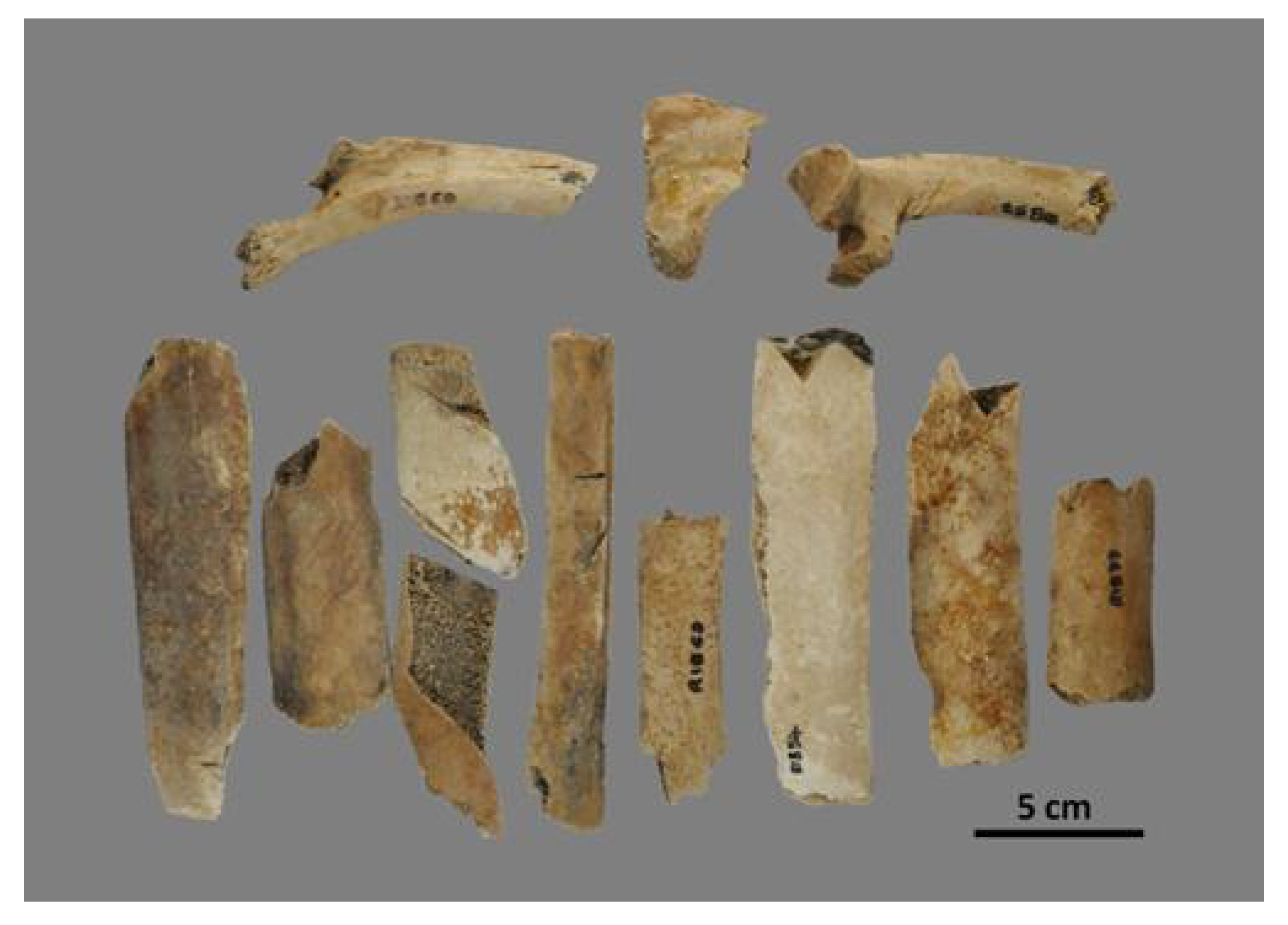Meat Supplies at the Ribadeo I Shipwreck (San Giacomo di Galizia galleon): Preliminary Results from Three Small Faunal Samples
Abstract
1. Introduction
2. Materials and Methods
3. Results
3.1. Preservation
3.2. Faunal Spectrum, Body Parts and Aging Data
3.3. Butchery Patterns
4. Discussion
5. Conclusions
Author Contributions
Funding
Institutional Review Board Statement
Data Availability Statement
Acknowledgments
Conflicts of Interest
References
- Marchena Giménez, J.M. La Vida y los Hombres de las Galeras de España (siglos XVI-XVII). Ph.D. Thesis, Universidad Complutense de Madrid, Madrid, Spain, 2010. [Google Scholar]
- Babío Walls, M. La vida cotidiana del hombre del mar andaluz en la Carrera de Índias: Hipótesis de un trabajo de historia naval. In Actas de las I Jornadas de Andalucía y América; La Rábida: Huelva, Spain, 1981. [Google Scholar]
- Hamilton, E.J. Wages and subsistence on Spanish treasure ships, 1503–1660. J. Political Econ. 1929, 37, 430–450. [Google Scholar] [CrossRef]
- Scott-Ireton, D.A. An examination of the Luna colonization fleet. In Underwater Archaeology; Babits, L.E., Fach, C., Harris, R., Eds.; The Society for Historical Archaeology: Uniontown, PA, USA, 1998; pp. 25–30. [Google Scholar]
- Migaud, P. A first approach to links between animals and life on board sailing vessels (1500–1800). Int. J. Naut. Archaeol. 2011, 40, 283–292. [Google Scholar] [CrossRef]
- Armitage, P.L. Victuals and vermin: Life on board the “Sea Venture” in 1609. Bull. Inst. Marit. Hist. Archaeol. 1987, 10, 8–10. [Google Scholar]
- Armitage, P.L. Ships’ rats, salted meat and tortoises: Aspects of maritime life in the great age of sail 1500–1800s. Bermud. J. Archaeol. Marit. Hist. 1989, 1, 143–159. [Google Scholar]
- Armitage, P.L. Social status and mutton consumption on board English East indiamen: Faunal evidence from the shipwreck Earl of Abergavenny (1805). In Animal Use and Culture Change; Crabtree, P.J., Ryan, K., Eds.; MASCA Research Papers in Science and Archaeology: Philadelphia, PA, USA, 1991; pp. 53–60. [Google Scholar]
- Armitage, P.L. The Deep-Sea Tortugas Shipwreck, Florida: The Animal Bones. In Oceans Odyssey 3. The Deep-Sea Tortugas Shipwreck, Straits of Florida: A Merchant Vessel from Spain’s 1622 Tierra Firme Fleet; Stemm, G., Kingsley, S., Eds.; Odyssey Marine Exploration Papers: Oxford, UK, 2013; Volume 29, pp. 151–169. [Google Scholar]
- Chapin, R.L. A faunal analysis of the 17th century galleon Nuestra Señora de Atocha. Master’s Thesis, University of Arizona, Tucson, AZ, USA, 1990. [Google Scholar]
- Clark, D.T. Preliminary Analysis of Faunal Remains from Shipwreck 31CR314. In Queen Anne’s Revenge Shipwreck Project; Research Report and Bulletin Series QAR-B-05-01; Underwater Archaeology Branch, Office of State Archaeology, Department of Cultural Resources: North Carolina, CA, USA, 2005; pp. 2–5. [Google Scholar]
- Scales, R. The Animal Bone. In Newport Medieval Ship Project. Updated Post Excavation Research Design; Powell, K., Ed.; Oxford Archaeological Unit Ltd.: Oxford, UK, 2010; pp. 54–56. [Google Scholar]
- Smith, R.C.; Spirek, J.; Bratten, J.; Scott-Ireton, D.A. The Emanuel Point Ship: Archaeological Investigations, 1992–1995; Florida Department of State, Division of Historical Resources, Bureau of Archaeological Research: Tallahassee, FL, USA, 1995. [Google Scholar]
- Colomer Marti, S. Primera approximació a l’estudi de les restes faunístiques del derelicte Culip VI. In Excavacions Arqueològiques Subàquatiques a Cala Culip; Nieto Prieto, J., Jover Armengol, A., Izquierdo Tugas, P., Eds.; Centre d’Investigacions Arqueològiques de Girona: Girona, Spain, 1989; pp. 295–308. [Google Scholar]
- Mira Caballos, E. La vida y la muerte a bordo de un navío del siglo XVI: Algunos aportes. Rev. Hist. Nav. 2010, 108, 39–57. [Google Scholar]
- Apestegui Cardenal, C. La vida a bordo: Condiciones de vida en un navío o galeón de la Armada real de la época del Guadalupe. In Navegantes y Naufragios. Galeones en la ruta del Mercurio; Sanchís Bueno, I., Ed.; Lunwerg: Barcelona, Spain, 1996; pp. 81–124. [Google Scholar]
- Fernández Torres, A. Diario de a bordo: La vida en una nave del siglo XVI. Clío. Rev. Historia 2007, 70, 38–49. [Google Scholar]
- Jáuregui-Lobera, I. Navegación e historia de la ciencia: La vida a bordo: Los hombres de la mar en el siglo XVI. JONNPR 2020, 5, 347–358. [Google Scholar]
- Eguiluz-Miranda, B.; Domínguez-Delmás, M.; San Claudio Santa Cruz, M.; Gasch-Tomás, J.L. Can we identify the ship through a multidisciplinary approach? The case of the Ribadeo I wreck (c.1597). In Heritage and the Sea: Maritime History and Archaeology of the Global Iberian world (15th–18th Centuries); Crespo-Solana, A., Castro, F., Nayling, N., Eds.; Springer: Cham, Switzerland, 2022; pp. 97–119. [Google Scholar]
- San Claudio, M.; González, R.; Casabán, J.L.; Castro, F.; Domínguez, M. El pecio de Ribadeo, un excepcionalmente bien conservado pecio español del siglo XVI. In Arqueología Subacuática Española: Actas del I Congreso de Arqueología Náutica y Subacuática Española; Nieto Prieto, F.X., Bethencourt Núñez, M., Eds.; Ministerio de Cultura: Madrid, Spain, 2014; Volume 1, pp. 208–221. [Google Scholar]
- Boessneck, J.; Müller, H.-H.; Teichert, M. Osteologische Unterscheidungsmerkmale zwischen Schaf (Ovis aries Linne) und Zeige (Capra hircus Linne). Kühn Archiv 1964, 78, 1–129. [Google Scholar]
- Silver, I.A. The ageing of domestic animals. In Science in Archaeology; Brothwell, D., Higgs, E.S., Eds.; Thames and Hudson: London, UK, 1969; pp. 283–302. [Google Scholar]
- Zeder, M.A. Reconciling rates of long bone fusion and tooth eruption and wear in sheep (Ovis) and goat (Capra). In Recent Advances in Ageing and Sexing Animal Bones; Ruscillo, D., Ed.; Oxbow Books: Oxford, UK, 2006; pp. 87–118. [Google Scholar]
- Driesch, A.v.d. A Guide to the Measurement of Animal Bones from Archaeological Sites; Peabody Museum Bulletin: Harvard, MA, USA, 1976. [Google Scholar]
- Poland, J.G. A methodological approach to the identification of duck and goose remains from archaeological sites with an application to Roman Britain. Ph.D. Thesis, University of Sheffield, Sheffield, UK, 2018. [Google Scholar]
- Ehrlich, F.; Aguraiuja-Lätti, Ü.; Lõugas, L.; Rannamäe, E. Application of morphometric and stable isotope analyses for distinguishing domestic and wild geese. Int. J. Osteoarchaeol. 2022, 32, 457–466. [Google Scholar] [CrossRef]
- Fernández-Jalvo, Y.; Andrews, P. Atlas of Taphonomic Identifications; Springer: Dordrecht, The Netherlands, 2016. [Google Scholar]
- Stathopoulou, E.; Phoca Cosmetatou, N.; Theodoropoulou, T.; Mallouchou, M.; Margariti, E.; Psycharis, V. Origin of archaeological black bones within a waterlogged context: A multidisciplinary approach. Palaeogeogr. Palaeoclimatol. Palaeoecol. 2019, 534, 109334. [Google Scholar] [CrossRef]
- Shahack-Gross, R.; Bar-Yosef, O.; Weiner, S. Black-colored bones in Hayonim Cave, Israel: Differentiating between burning and oxide staining. J. Archaeol. Sci. 1997, 24, 439–446. [Google Scholar] [CrossRef]
- Stathopoulou, E.; Theodoropoulou, T.; Phoca-Cosmetatou, N. Black Fish Bones in Waterlogged Deposits: The Case of the Neolithic Lake Settlement of Dispilio, Greece. Archaeofauna 2013, 22, 51–74. [Google Scholar]
- Moreno-García, M. Mammal and bird bone from the barbican well (mid-late 15th to early 16th-centuries) (Site 777N). In Norwich Castle: Excavations and Historical Surrey, 1987/98. Part III: A Zooarchaeological Study; Ayers, B., Ed.; NAU Archaeology, and Historic Environment, Norfolk Museums and Archaeology Service: Norwich, UK, 2009; pp. 95–130. [Google Scholar]
- Bramwell, D. Bird Bone. In Excavations at King’s Lynn, 1963–1970; Clarke, H., Carter, A., Eds.; The Society for Medieval Archaeology. Monograph Series 7: London, UK, 1977; pp. 399–402. [Google Scholar]
- Allison, E.P. Archaeozoological study of bird bones from seven sites in York. Ph.D. Thesis, University of York, York, UK, 1985. [Google Scholar]
- Hutton-MacDonald, R.; MacDonald, K.C.; Ryan, K. Domestic geese from Medieval Dublin. Archaeofauna 1993, 2, 205–218. [Google Scholar]
- Reichstein, H.; Pieper, H. Untersuchungen an Skelettresten von Vögeln aus Haithabu (Ausgrabung 1966–1969); Karl Wachholtz Verlag: Neumünster, Germany, 1986. [Google Scholar]
- Bacher, A. Vergleichend morphologische Untersuchungen an Einzelknochen des postkranialen Skeletts in Mitteleuropa vorkommender Schwäne und Gänse. Master’s Thesis, Universität München, München, Germany, 1967. [Google Scholar]
- Hayes, P.W.; Matthews, J.A.; Allaire, B.; Holm, P. European naval diets in the sixteenth century: A quantitative method for comparative and nutritional analysis. Hist. Methods A J. Quant. Interdiscip. Hist. 2019, 52, 195–212. [Google Scholar] [CrossRef]
- Phillips, C.R. Six Galleons for the King of Spain. Imperial Defense in the Early Seventeenth Century; John Hopkins University Press: Baltimore, MD, USA, 1986. [Google Scholar]
- Moreno-García, M.; Detry, C. The dietary role of hens, chickens and eggs among a 17th-century monastic order: The Clarisse of Santa Clara-a-Velha, Coimbra (Portugal). In Birds in Archaeology; Prummel, W., Zeiler, J., Brinkhuizen, D., Eds.; Groningen Institute for Archaeologie: Groningen, The Netherlands, 2008; pp. 45–55. [Google Scholar]
- Moreno-García, M.; Pimenta, C.M. Beyond chicken: Avian biodiversity from a Portuguese late medieval urban site. In Birds in Archaeology; Prummel, W., Zeiler, J., Brinkhuizen, D., Eds.; Groningen Institute for Archaeologie: Groningen, The Netherlands, 2008; pp. 263–277. [Google Scholar]
- Peña Chocarro, L.; Pérez Jordà, G.; Moreno García, M.; López De Calle Cámara, C.; Tudanca, J.M. Subsistencia y producción de alimentos en un entorno rural: El yacimiento de La Noguera (Tudelilla, La Rioja). In Miscelánea en Homenaje a Lydia Zapata Peña (1965–2015); Fernández Eraso, J., Mujika Alustiza, J.A., Arrizabalaga Valbuena, Á., García Díez, M., Eds.; UPV: Bilbao, Spain, 2017; pp. 219–246. [Google Scholar]
- De Castro Martínez, T. La Alimentación en Las Crónicas Castellanas Bajomedievales; Universidad de Granada: Granada, Spain, 1996. [Google Scholar]
- Morales-Muñiz, A.; González-Gómez de Agüero, E.; Fernández-Rodríguez, C.; Saborido Rey, F.; Llorente-Rodriguez, L.; López-Arias, B.; Roselló-Izquierdo, E. Hindcasting to forecast. An archaeobiological approach to the European hake (Merluccius merluccius, Linnaeus 1758) fishery: Iberia and beyond. Reg. Stud. Mar. Sci. 2018, 21, 21–29. [Google Scholar] [CrossRef]




| Sample | BOS | OVA | O/C | SUS | MSM | AVE | PISCIS | UNI | Total |
|---|---|---|---|---|---|---|---|---|---|
| HU/001 | 5 | 1 | - | - | - | - | - | - | 6 |
| HU/006 | 37 | 4 | 6 | 2 | 7 | 1 | 1 | 4 | 62 |
| HU/010 | 9 | - | 1 | - | - | - | - | - | 10 |
| TOTAL | 51 | 5 | 7 | 2 | 7 | 1 | 1 | 4 | 78 |
| GL | SC | |||||||
|---|---|---|---|---|---|---|---|---|
| Mean | Min | Max | n | Mean | Min | Max | n | |
| Ribadeo I shipwreck | 77.2 | 1 | 7.1 | 1 | ||||
| Norwich, Barbican well, UK [31] | 84.6 | 78.0 | 92.0 | 20 | 8.1 | 7.7 | 8.9 | 30 |
| King’s Lynn, UK [32] | 81.1 | 75.0 | 86.0 | 10 | 7.6 | 7.3 | 8.3 | 10 |
| York, UK [33] | 83.6 | 78.5 | 89.2 | 12 | ||||
| Wood Quay, Ireland [34] | 83.9 | 77.1 | 90.8 | 69 | ||||
| Haithabu, Germany [35] | 86.1 | 78.0 | 96.8 | 37 | ||||
| Modern domestic goose [36] | 92.2 | 81.8 | 103.0 | 17 | 8.4 | 7.4 | 9.7 | 17 |
| Modern wild goose [36] | ||||||||
| Male | 85.1 | 79.5 | 91.3 | 10 | 7.5 | 7.0 | 8.9 | 10 |
| Female | 79.3 | 74.4 | 83.7 | 11 | 6.9 | 6.6 | 7.3 | 11 |
| BOS | OVA | O/C | SUS | MSM | TOTAL | |
|---|---|---|---|---|---|---|
| Skull | ||||||
| Skull | 8 | - | 1 | - | - | 9 |
| Upper teeth | 1 | - | 3 | - | - | 4 |
| Axial | ||||||
| Atlas | 2 | - | - | - | - | 2 |
| Axis | 1 | - | - | - | - | 1 |
| Vertebrae | 7 | - | - | - | - | 7 |
| Ribs | 13 | - | 1 | 1 | 7 | 22 |
| Upper fore limb | ||||||
| Scapula | - | 1 | - | - | - | 1 |
| Humerus (d) | 1 | - | 1 | - | - | 2 |
| Lower fore limb | ||||||
| Radius (p) | 3 | 1 | - | - | - | 4 |
| Radius (d) | 1 | - | - | - | - | 1 |
| Ulna | 3 | - | - | - | - | 3 |
| Metacarpal (d) | 1 | - | - | - | - | 1 |
| Upper hind limb | ||||||
| Pelvis | - | - | - | 1 | - | 1 |
| Femur (d) | 3 | - | - | - | - | 3 |
| Lower hind limb | ||||||
| Tibia (d) | - | 2 | - | - | - | 2 |
| Calcaneus | - | - | 1 | - | - | 1 |
| Feet | ||||||
| Phalanx 2 | 2 | - | - | - | - | 2 |
| Phalanx 3 | - | 1 | - | - | - | 1 |
| Long bone fragments | 5 | - | - | - | - | 5 |
| TOTAL | 51 | 5 | 7 | 2 | 7 | 72 |
Disclaimer/Publisher’s Note: The statements, opinions and data contained in all publications are solely those of the individual author(s) and contributor(s) and not of MDPI and/or the editor(s). MDPI and/or the editor(s) disclaim responsibility for any injury to people or property resulting from any ideas, methods, instructions or products referred to in the content. |
© 2023 by the authors. Licensee MDPI, Basel, Switzerland. This article is an open access article distributed under the terms and conditions of the Creative Commons Attribution (CC BY) license (https://creativecommons.org/licenses/by/4.0/).
Share and Cite
Moreno-García, M.; San Claudio Santa Cruz, M.; Crespo Solana, A. Meat Supplies at the Ribadeo I Shipwreck (San Giacomo di Galizia galleon): Preliminary Results from Three Small Faunal Samples. Heritage 2023, 6, 1118-1127. https://doi.org/10.3390/heritage6020062
Moreno-García M, San Claudio Santa Cruz M, Crespo Solana A. Meat Supplies at the Ribadeo I Shipwreck (San Giacomo di Galizia galleon): Preliminary Results from Three Small Faunal Samples. Heritage. 2023; 6(2):1118-1127. https://doi.org/10.3390/heritage6020062
Chicago/Turabian StyleMoreno-García, Marta, Miguel San Claudio Santa Cruz, and Ana Crespo Solana. 2023. "Meat Supplies at the Ribadeo I Shipwreck (San Giacomo di Galizia galleon): Preliminary Results from Three Small Faunal Samples" Heritage 6, no. 2: 1118-1127. https://doi.org/10.3390/heritage6020062
APA StyleMoreno-García, M., San Claudio Santa Cruz, M., & Crespo Solana, A. (2023). Meat Supplies at the Ribadeo I Shipwreck (San Giacomo di Galizia galleon): Preliminary Results from Three Small Faunal Samples. Heritage, 6(2), 1118-1127. https://doi.org/10.3390/heritage6020062







